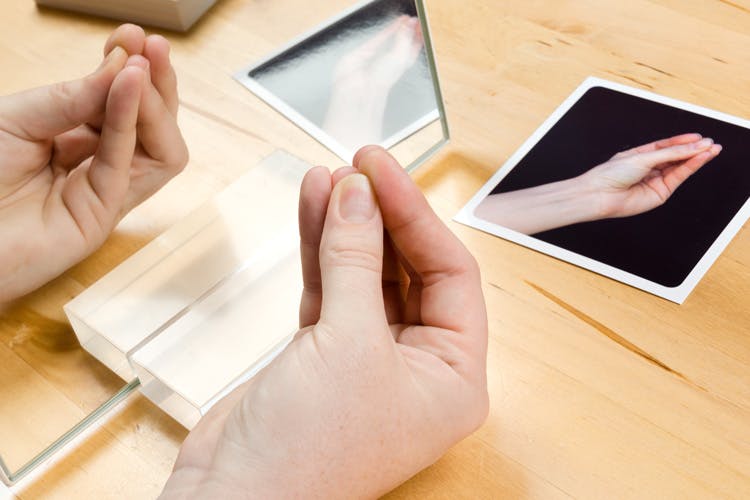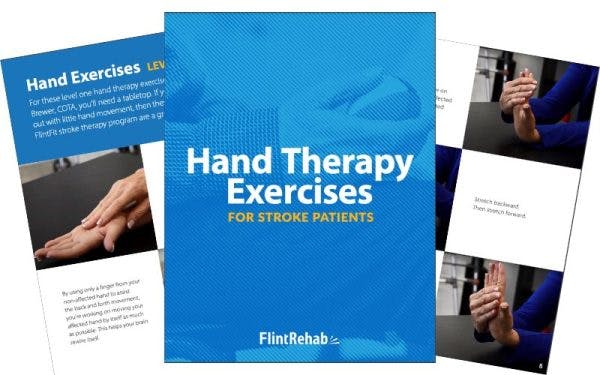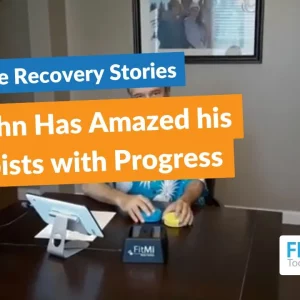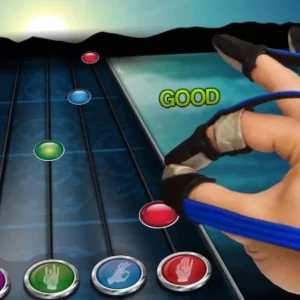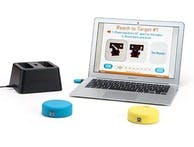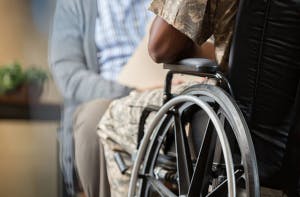It is possible to treat hand paralysis using sensory inputs to your brain. Sensory stimulation to the brain comes in a variety of forms: vision, hearing, touch, taste, smell, and proprioception (joint position sense). The term sensory refers to any way your brain receives information from the outside world.
Loss of hand function can be very frustrating after Stroke. When there is little to no movement in the hand, it can seem difficult to spark recovery. However, there are still ways to stimulate the cortex and begin recovery, even with a flaccid hand. Using sensory stimulation in a way that references your hand can stimulate the part of the cortex that coordinates hand use.
Recovering from Hand Paralysis
After a significant stroke, hemiparesis is typical, often including hand paralysis. In larger strokes, when there are so many deficits to focus on for rehabilitation, sometimes less time is given to the hand, especially when it initially shows little to no movement ability. Sometimes, it is easy to assume there is no hope to regain hand movement.
Remember there is always an opportunity to stimulate your brain’s cortex and increase neuroplasticity. Adding sensory stimulation to your exercises or daily activities is helpful to bring about that neuroplasticity.
Mirror Therapy is a way to engage your brain’s cortex by providing sensory stimulation to those parts of your brain via visual cues. Typically, mirror therapy involves using a tabletop mirror to reflect your functional hand in place of your affected hand. (See the photo at the top of this post.) This creates the illusion that both hands are moving and tricks your brain into thinking that your affected hand is working properly. Although you logically know it’s just a reflection, this still helps activate neuronal processes and begins rewiring the brain through the process of neuroplasticity.
Adding Sensory Stimulation
Music Therapy is another way to stimulate neuroplasticity by engaging the senses. The benefits to Music in rehabilitation are extensive and varied. Auditory stimulation used during music therapy can help prepare the brain to anticipate movement. But in addition, music has an emotional affect that can influence physiological changes in heart rate, blood pressure, and muscle tension.
In one application, we would like to share a story of how an individual applied the concepts of mirror therapy with music for powerful outcomes. Margaret, a post-rehabilitation exercise specialist tells her story of using mirror therapy in an interesting modified way to help her husband to recover some muscle activity in his hand. She initially purchased Flint Rehab’s MusicGlove for hand therapy at home. Then she used the MusicGlove to help her husband regain hand function by combining it with mirror therapy – with a twist.
Hand Paralysis Treatment, Margaret’s Way
Please note this is an anecdotal account and cannot be extrapolated to all circumstances. However, we have included links to clinical studies that support the basic principles of this hand recovery method for you to consider how to apply these principles to your unique needs.
The approach she took for her husband’s hand paralysis treatment is outlined below. We hope it inspires your recovery.
Use Mirror Therapy Differently
Margaret used the principles of mirror therapy for his hand paralysis treatment, but she substituted the visual cue of the mirror for the auditory and proprioceptive stimulation of the functional hand.
She placed the MusicGlove on her husband’s functional hand and had him exercise with MusicGlove normally. Meanwhile, she would assist his affected hand to mirror his movements.
She wouldn’t move his hand to the game; she moved his impaired hand to exactly match what his opposite hand was doing. So, if he missed a note, she missed a note.
This mirroring and passive movement, along with the music and proprioceptive inputs to his cortex, helped her husband’s brain rewire.
Because of this unique therapy, he went from being completely flaccid to experiencing twitches! Any survivor struggling with paralysis knows what a significant and noteworthy sign of recovery this amount of movement is.
Margaret’s husband saw remarkable results with MusicGlove because this device utilizes a high number of repetitions. In fact, the average user achieves hundreds of repetitions per session.
Find ways to make our free hand therapy exercise book more interesting and stimulating to your senses and you will make progress.
Want 25 pages of hand therapy exercises in PDF form? Click here to download our free Hand Therapy Exercise ebook now (link opens a pop up for uninterrupted reading)
Don’t Get Discouraged
Your results may come slowly at first — almost painstakingly so. Try to be as patient as you can with yourself. After all, you’re rewiring your brain. It’s a complex process that involves time and hard work.
Trust the hand paralysis treatment process and know that although results aren’t showing immediately, your brain is hard at work trying to make something happen.
Signs of Recovery from Hand Paralysis
Every recovery is different, so everyone will see results at different speeds. Margaret’s husband was able to see twitches after just a few weeks of this combined sensory exercise.
While twitches are small movements, they are a big deal for someone recovering from hand paralysis. Even when the prognosis is grim, there is always hope for recovery.

